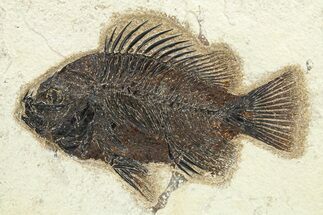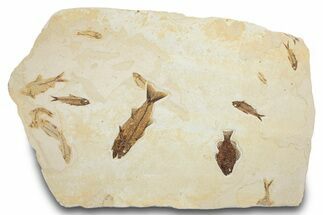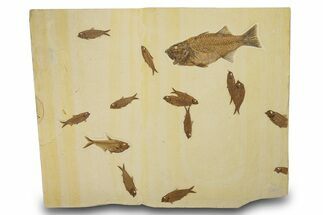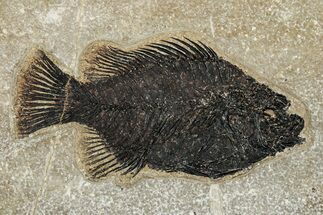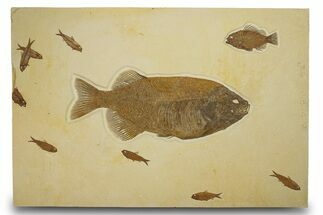This Specimen has been sold.
5.5" Fossil Fish (Priscacara) With Knightia - Wyoming
This is a beautiful, 5.5" long fish (Priscacara serrata) from the Green River Formation. It was collected from Warfield's Quarry near Kemmerer, Wyoming. The detail on this specimen is amazing with all of the scales well preserved.
This specimen includes an acrylic display stand.
This specimen includes an acrylic display stand.
Priscacara is an extinct genus of temperate bass that lived during the Eocene. It is an uncommon species in the Green River Formation, representing less than 1 percent of total fish fossils. It is a favorite among fossil collectors, particularly those specimens with all of their dorsal spines pointing upwards. It can occasionally reach impressive sizes in excess of 16 inches in length. Priscacara has a large mouth and impressive array of teeth can often be seen in detail on larger, well-preserved specimens.
Priscacara is more frequently found in shoreline lake deposits and less frequently found in rocks deposited in the center of the lake. Its appearance is very similar to that of Cockerellites, a genus of smaller schooling fish found in large numbers in the mid-lake quarries. Cockerellites maxed out in the 5 to 6-inch range, so specimens larger than that are assumed to be Priscacara. Cockerellites have more dorsal and anal fin rays than Priscacara and a significantly smaller mouth.
Priscacara is more frequently found in shoreline lake deposits and less frequently found in rocks deposited in the center of the lake. Its appearance is very similar to that of Cockerellites, a genus of smaller schooling fish found in large numbers in the mid-lake quarries. Cockerellites maxed out in the 5 to 6-inch range, so specimens larger than that are assumed to be Priscacara. Cockerellites have more dorsal and anal fin rays than Priscacara and a significantly smaller mouth.
Knightia is an extinct genus of schooling, ray-finned, spindle-shaped, bony fish that shares a family with herrings and sardines. They lived in the freshwater (lacustrine) environments of North America and were eaten by just about everything that was bigger. They ate insects and smaller fish, and used gill rakers to feast on plankton. Knightia eocena is the largest of the three species of Knightia, with a typical length of about 15 centimeters. It is the state fossil of Wyoming.
These fish had rows of dorsal and ventral scutes running from the back of the head to the medial fins. They had heavy scales, and small conical teeth. They are popular finds in the Wyoming lagerstätte, and were a primary food source to the large and hungry vertebrates of that once hunted the Green River Formation.
The Green River Formation is an Eocene geologic formation that records the sedimentation in a group of intermountain lakes in three basins along the present-day Green River in Colorado, Wyoming, and Utah. The Eocene spanned approximately 55.8 to 33.8 million years ago. This formation has distinct stratigraphy that displays alternating light and dark layers representing seasonal erosion and deposition.
Freshwater basins, charged by the Uinta Mountains on the Wyoming-Utah border, contained an enormous representation of taxa. The beginning of the Eocene was marked by warm upper latitudes, a greenhouse atmosphere rich in methane and carbon dioxide, and local climates stabilized by large lakes populated by such creatures as crocodiles. Fossil Lake in Wyoming, of which the Green River Formation includes, is known for its well-preserved warm, lacustrine ecology.
The end of the Eocene was dramatically different, with the onset of icehouse climate characteristics, a change in atmospheric chemistry, and possible bolide impacts. The Green River fossils date about 48 million years, but cover several million years, including the transition between the moist early Eocene climate and the slightly drier mid-Eocene.
These fish had rows of dorsal and ventral scutes running from the back of the head to the medial fins. They had heavy scales, and small conical teeth. They are popular finds in the Wyoming lagerstätte, and were a primary food source to the large and hungry vertebrates of that once hunted the Green River Formation.
The Green River Formation is an Eocene geologic formation that records the sedimentation in a group of intermountain lakes in three basins along the present-day Green River in Colorado, Wyoming, and Utah. The Eocene spanned approximately 55.8 to 33.8 million years ago. This formation has distinct stratigraphy that displays alternating light and dark layers representing seasonal erosion and deposition.
Freshwater basins, charged by the Uinta Mountains on the Wyoming-Utah border, contained an enormous representation of taxa. The beginning of the Eocene was marked by warm upper latitudes, a greenhouse atmosphere rich in methane and carbon dioxide, and local climates stabilized by large lakes populated by such creatures as crocodiles. Fossil Lake in Wyoming, of which the Green River Formation includes, is known for its well-preserved warm, lacustrine ecology.
The end of the Eocene was dramatically different, with the onset of icehouse climate characteristics, a change in atmospheric chemistry, and possible bolide impacts. The Green River fossils date about 48 million years, but cover several million years, including the transition between the moist early Eocene climate and the slightly drier mid-Eocene.
50 million years ago, in the Eocene, these fish thrived in Fossil Lake, which was fed by the Uinta and Rocky Mountain highlands. The anoxic conditions at the bottom of Fossil Lake slowed bacterial decomposition, prevented scavengers from disturbing corpses and, most interestingly, suffocated creatures that ventured into the oxygen-starved aquatic layer. The result is a miraculous exhibition of Eocene biota: a subtropical aquatic community within sycamore forests, teeming with creatures such as freshwater stingrays, dog-sized horses, menacing alligators, early flying bats, and one of the first primates.
SPECIES
Priscacara serrata & Knightia eocaena
LOCATION
Fossil Safari Quarry, Kemmerer, Wyoming
FORMATION
Green River Formation
SIZE
Priscacara: 5.5" long, Rock: 7.8 x 5.1"
CATEGORY
SUB CATEGORY
ITEM
#240367
We guarantee the authenticity of all of our
specimens. Read more about our
Authenticity Guarantee.
specimens. Read more about our
Authenticity Guarantee.
 Reviews
Reviews


